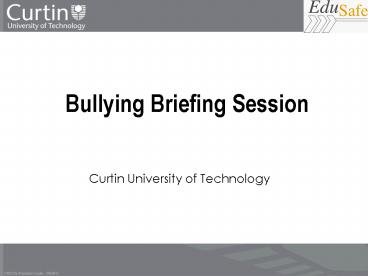Bullying Briefing Session - PowerPoint PPT Presentation
1 / 15
Title: Bullying Briefing Session
1
Bullying Briefing Session
- Curtin University of Technology
2
Objectives
- By the end of this session staff will be able to
- Explain what bullying is
- List the impact of bullying
- Describe the Universitys policy on bullying
- Explain what someone could do if they are
experiencing bullying
3
What Is It?
- Bullying is repeated inappropriate behaviour,
direct or indirect, whether verbal, physical or
otherwise, conducted by one or more persons
against another or others, that a reasonable
person would regard as undermining the
individuals right to dignity through
victimising, harming, humiliating, intimidating
or threatening a person or persons, thereby
creating a risk to health and safety. (Source
WorkSafe WA 2003)
4
What Constitutes Bullying?
- OVERT
- eg verbal abuse
- threat of physical
- violence
- COVERT
- eg subtle intimidation
- - Inappropriate comments
- about personal appearance
- - Constant criticisms
- - Isolation and or exclusion
- - Unrealistic, embarrassing
- or degrading demands
5
Recognising Bullying Examples
- Abusive, insulting or offensive language
- Behaviour or language that frightens, humiliates,
belittles or degrades, including criticism
delivered with a raised voice (yelling or
screaming) - Inappropriate comments about appearance,
lifestyle or family - Interfering with personal effects or work
equipment - Physical assaults or threats
6
Recognising Bullying Examples
- Behaviour that undermines, treats less favourably
or disempowers including overloading setting
timelines difficult to achieve, setting tasks
beyond skill level, deliberately denying access
to information or resources, or unfair treatment
in relation to accessing entitlements such as
leave or training - Inappropriate written communication including
email and telephone text messaging
7
Sources
- Bullying can take place between a manager or
supervisor and subordinate between co-workers
between a staff member and a student or between
students. - Bullying may occur downwards, conducted by
managers towards their staff or students,
upwards, directed at managers from their staff
or students, or horizontally, from one
colleague to another. - It may also refer to abusive group behaviour that
is prolonged or systematic and otherwise known as
workplace mobbing.
8
What does not constitute bullying?
- Recognise employers managerial prerogative.
- Differentiate bullying from legitimate authority.
- Employers right to direct and govern how work is
done, monitor workflow management performance. - Importance of adherence to appropriate protocols.
- Consider appropriateness of delivery company
code of conduct.
9
Some Stories
10
Impact
- Personal
- Stress, anxiety
- Isolation
- Depression
- Loss of self esteem/ confidence
- Impaired decision making ability
- Financial implications
- Ill health
- Increased risk of injury
- Poor relationships
- Organisational
- Unsafe work environment
- Poor teamwork
- Poor morale
- Commitment/ loyalty
- Recruitment/ retention
- Increased Insurance premiums (w/comp)
- Absenteeism/ sickness
- Poor public image
- Overall financial cost
11
Action _at_ Curtin
- Curtins commitment to prevention management of
bullying - All staff students have right to operate in
environment free from bullying - All required to demonstrate appropriate behaviour
and respect one anothers right to dignity - Development of policy procedure
- Complimentary information educational resources
- Review monitor incidents procedures for
continuous improvement
12
Information Training
13
Procedures
- Complete a self-audit checklist
- Seek advice
- Keep a record
- Report the situation
- Consider the options for resolution
- No action
- Deal directly with respondent
- Deal with respondent with third party assistance
- Approach the manager of the respondent
- Referral to Manager, Conflict resolution
14
Information Resources
- Brochure
- Website
- http//www.edusafe.curtin.edu.au/curtin/bullyi
ng.html - Further training offered from early 2006
- Increasing Specialist Contact Officers
- WorkSafe WA
15
Comments Questions































